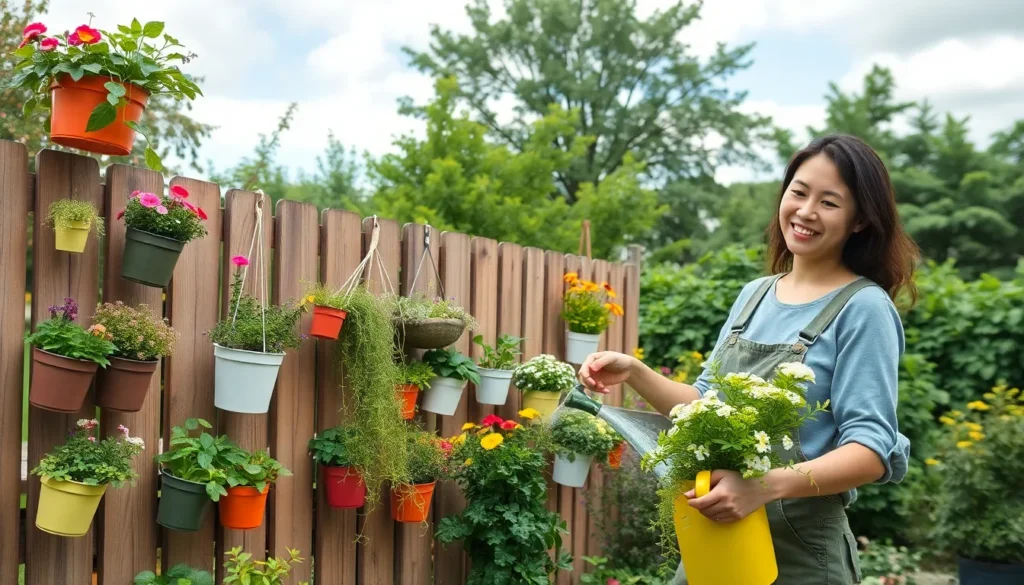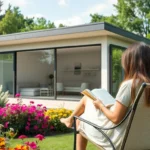Transform your ordinary fence into a stunning garden masterpiece that’ll make your neighbors stop and stare. We’ve discovered that fences aren’t just property dividers – they’re incredible opportunities to create vertical gardens that maximize your growing space while adding serious curb appeal to your home.
Whether you’re dealing with a chain-link eyesore or a basic wooden fence that needs personality, we’ll show you creative ways to turn that blank canvas into a thriving garden oasis. From hanging planters and trellises to living walls and herb gardens, these fence garden ideas work perfectly for any budget or skill level.
We’re talking about answers that don’t require major construction or expensive renovations. With the right plants and simple DIY techniques, you’ll create a beautiful garden feature that provides privacy, attracts beneficial wildlife, and gives you fresh herbs or flowers right outside your door.
Creative Vertical Fence Garden Ideas for Small Spaces
Small yards shouldn’t limit your gardening dreams. We can transform even the tiniest outdoor spaces into lush vertical gardens using strategic fence installations.
Living Wall Planters
Living wall planters create stunning displays that turn blank fence surfaces into vibrant garden features. We recommend installing modular planting systems that stack vertically along fence lines, allowing you to grow everything from succulents to vegetables in compact arrangements.
Felt pocket planters offer an affordable solution for creating instant living walls on chain link or wooden fences. These systems typically hold 20-30 plants per panel and work exceptionally well for herbs like basil, mint, and oregano. Wood frame planters with built in irrigation systems provide long term answers for larger installations.
Succulent walls require minimal maintenance while delivering maximum visual impact throughout the year. We suggest combining different textures and colors using varieties like hens and chicks, jade plants, and string of pearls. These drought tolerant options thrive in vertical environments and create cascading effects.
Hanging Basket Systems
Hanging basket systems maximize growing space without taking up ground area in cramped yards. We can install tiered hanging arrangements using sturdy fence brackets that support multiple baskets at varying heights.
Pulley systems make maintenance easier by allowing baskets to be lowered for watering and pruning. These mechanisms work particularly well for trailing plants like strawberries, cherry tomatoes, and flowering vines. Most pulley systems can handle up to 25 pounds per basket.
Cascading arrangements create dramatic vertical displays using plants with different growth habits. We recommend starting with upright plants at the top tier, adding bushy varieties in the middle, and finishing with trailing species at the bottom. This layered approach maximizes both growing space and visual appeal.
Pocket Garden Installations
Pocket gardens transform fence surfaces into organized growing spaces using individual planting compartments. We can create these installations using repurposed materials like old gutters, wooden crates, or specially designed fabric pockets.
Modular pocket systems allow for easy reconfiguration as your garden needs change throughout the seasons. These systems typically feature 6-12 pockets per panel and work well for compact plants like lettuce, spinach, and small flowering annuals. Installation requires only basic tools and can be completed in under two hours.
Fabric pocket installations offer excellent drainage and root aeration for healthy plant growth. We recommend using UV resistant materials that can withstand outdoor conditions for multiple growing seasons. These lightweight systems work on virtually any fence type without requiring additional structural support.
DIY Fence Garden Projects Anyone Can Build
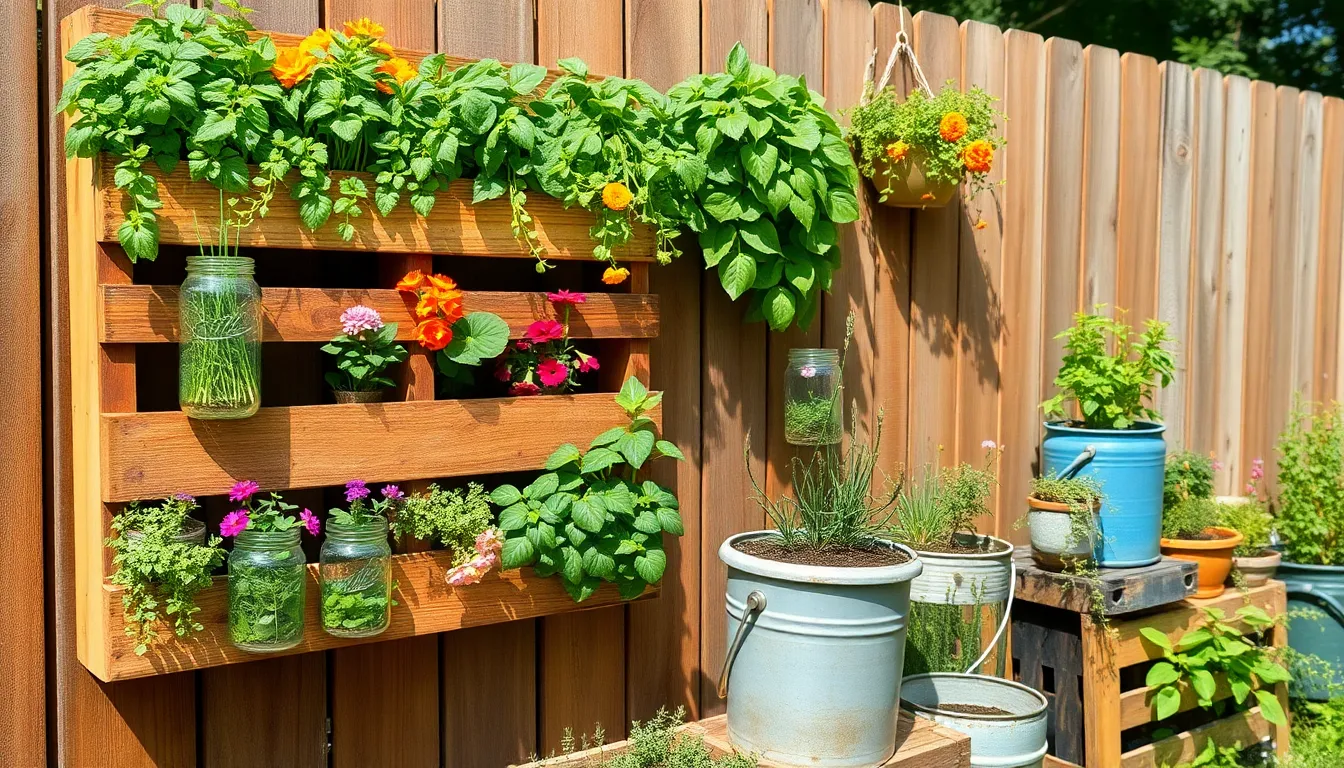
We’ve compiled three simple fence garden projects that transform basic materials into stunning vertical growing spaces. Each project uses readily available supplies and requires only basic tools to complete.
Pallet Garden Walls
Wooden pallets create impressive vertical gardens that maximize growing space in small yards. We mount these repurposed pallets directly against existing fences and fill them with quality potting soil. The slat design naturally forms individual planting pockets perfect for herbs, succulents, or colorful flowers.
This budget friendly approach works exceptionally well in urban settings where ground space is limited. Simply secure the pallet vertically using heavy duty brackets, line each section with industry fabric, and add your chosen plants. The rustic wood appearance complements most garden styles while providing excellent drainage for healthy plant growth.
Mason Jar Herb Gardens
Glass mason jars attached to fence surfaces create charming herb gardens that bring fresh flavors within easy reach. We secure each jar using simple mounting brackets positioned at varying heights for visual interest. This method works perfectly for kitchen herbs like basil, parsley, oregano, and thyme.
Each jar holds a single herb plant and requires only basic supplies: standard mason jars, metal mounting hardware, and your favorite herb varieties. The transparent glass allows us to monitor root development and water levels easily. Position jars near outdoor cooking areas or kitchen windows for convenient harvesting during meal preparation.
Repurposed Container Gardens
Old buckets, wooden crates, and decorative baskets transform into unique fence planters with minimal effort. We attach these containers using hooks or sturdy brackets spaced according to each container’s weight and size. This upcycling approach reduces waste while creating personalized garden displays.
Containers accommodate various plant types from trailing vines to upright vegetables depending on their depth and drainage capacity. Drill drainage holes in solid containers and consider adding a layer of gravel before filling with potting mix. The mixed container sizes and shapes add ever-changing visual texture to plain fence surfaces while supporting diverse plant collections.
Beautiful Flowering Fence Garden Designs
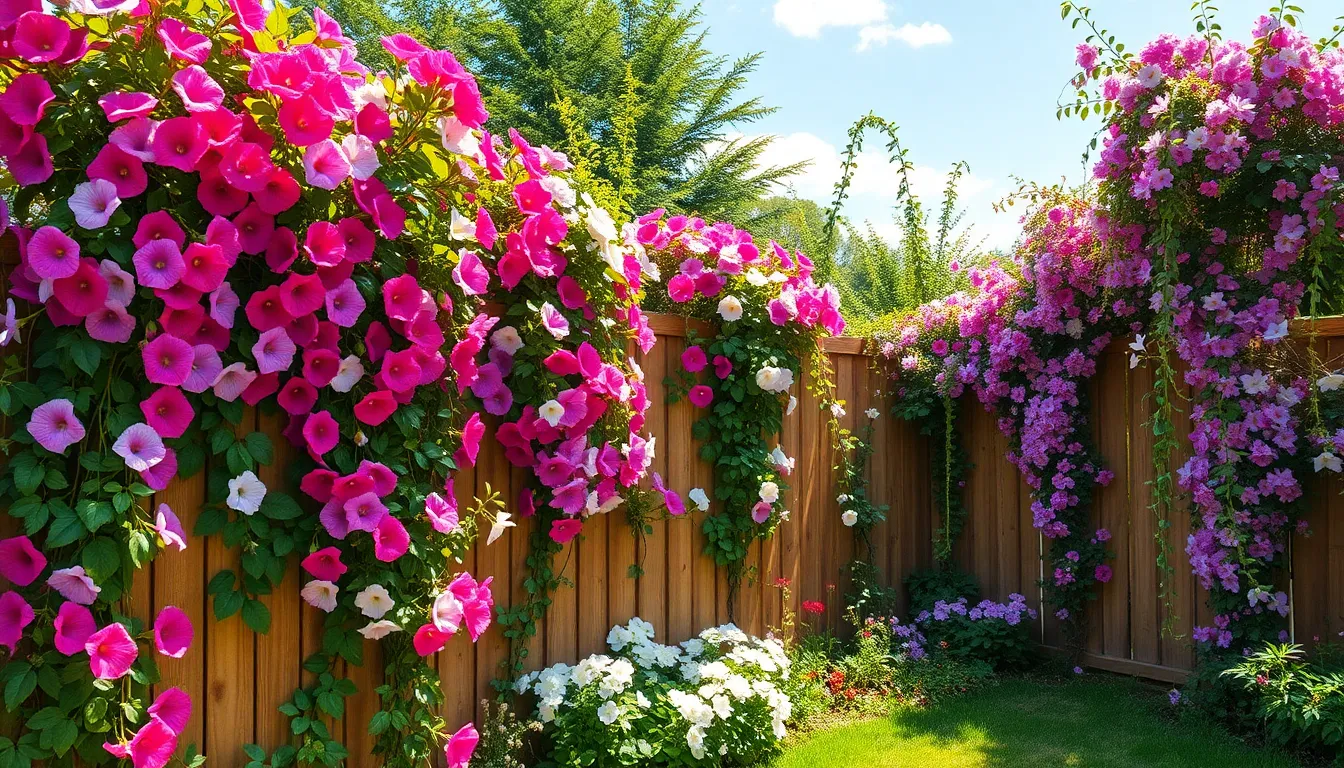
Flowering fence designs transform utilitarian barriers into vibrant living walls that create stunning visual impact while improving your garden’s overall sense of calm and seclusion. We’ll explore three exceptional flowering fence approaches that maximize vertical growing space and deliver continuous seasonal color.
Climbing Rose Trellises
Climbing rose trellises offer the ultimate romantic fence garden feature with their stunning floral displays and intoxicating fragrance. We recommend training climbing varieties like ‘Eden’ or ‘New Dawn’ up lattice panels or wire trellises attached directly to fence posts. These vigorous growers can reach 8-12 feet tall and produce hundreds of blooms throughout the growing season.
Installation involves mounting sturdy trellis panels 6-8 inches away from the fence surface to ensure proper air circulation. Train young canes horizontally along the trellis framework to encourage maximum flower production along the entire length. Established climbing roses can produce 50-100 blooms per season on a single 8-foot section of fence.
Morning Glory Privacy Screens
Morning glory vines create fast growing natural privacy screens that burst with colorful trumpet shaped flowers from summer through fall. These annual climbers can grow 10-15 feet in a single season and produce hundreds of 3-inch blooms in shades of purple, blue, pink, and white. We’ve found that ‘Heavenly Blue’ and ‘Grandpa Ott’ varieties perform exceptionally well on sunny fence lines.
Plant morning glory seeds directly along the fence base in late spring after soil temperatures reach 65°F. Space seeds 6 inches apart and provide string or wire supports for initial climbing. Full sun exposure and well drained soil produce the most vigorous growth and abundant flowering. Expect complete fence coverage within 60-90 days of planting.
Clematis and Vine Combinations
Clematis combinations with complementary flowering vines create diverse multi season displays that maximize fence garden interest. Pairing large flowered clematis varieties like ‘Jackmanii’ with sweet smelling honeysuckle or fragrant sweet peas produces layered textures and extended bloom periods. We recommend combining early spring flowering clematis with summer blooming companions for continuous color.
Plant different vine varieties at 3-4 foot intervals along the fence line to create natural growing zones. Install sturdy arbor structures or expanded metal panels to support heavy vine loads as plants mature. These mixed plantings can produce blooms from April through October with proper variety selection and care.
Edible Fence Garden Ideas for Fresh Produce
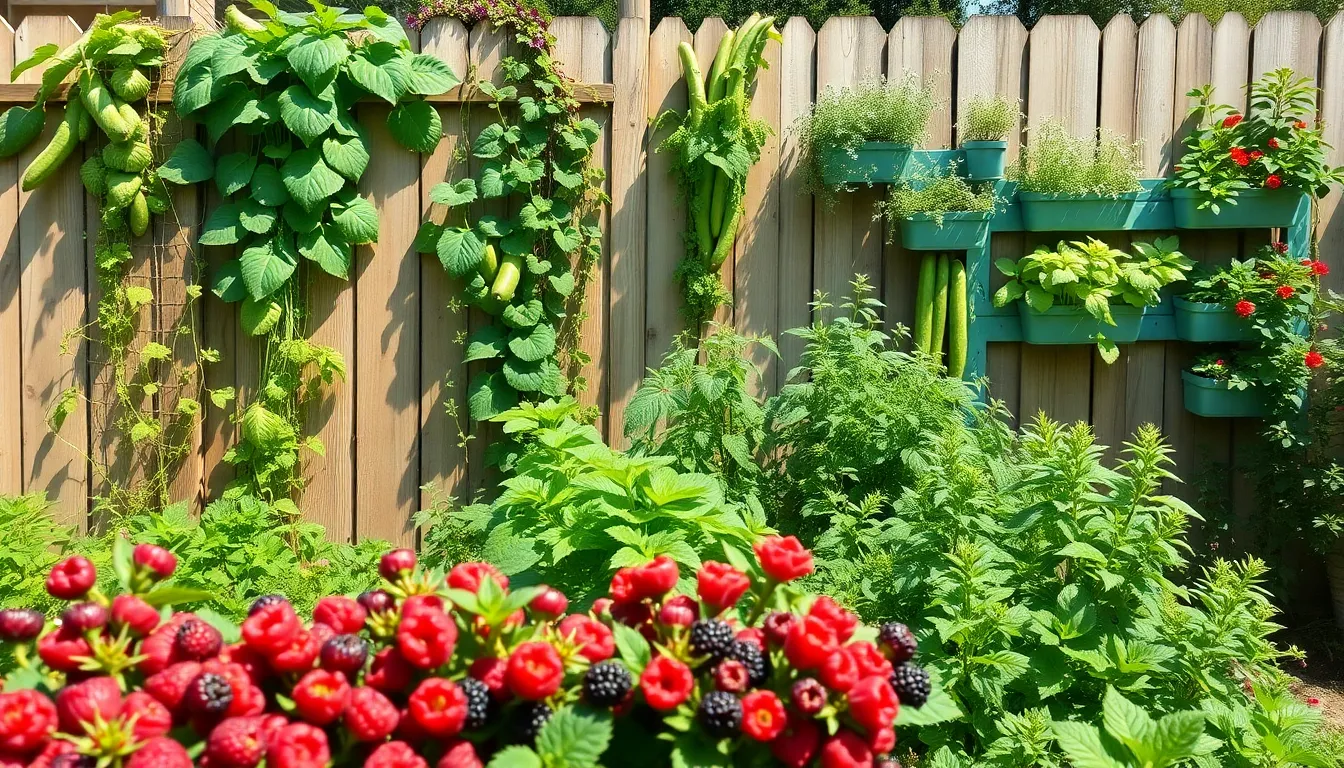
Growing your own food directly on fence structures transforms ordinary barriers into productive garden spaces. These edible fence answers provide fresh ingredients while creating natural privacy screens that serve dual purposes.
Vertical Vegetable Gardens
Vertical vegetable gardens maximize limited space by utilizing fence structures as natural support systems. Vining crops like pole beans, cucumbers, and peas thrive when trained on trellises or mesh attached directly to existing fences. We recommend installing sturdy wire mesh or wooden lattice panels to provide adequate climbing surfaces for these productive plants.
Growing vegetables vertically allows for easy harvesting at eye level and efficient use of available real estate. Cherry tomatoes perform exceptionally well in these setups, producing abundant fruit throughout the growing season. Most vertical vegetable installations require full sun exposure and regular watering to maintain healthy growth patterns.
Herb Wall Installations
Herb walls create compact growing systems perfect for small gardens and urban spaces with limited ground area. Popular herb choices include basil, thyme, oregano, and mint, which adapt well to vertical planters or wall mounted containers. These aromatic installations provide year round flavor for cooking while improving the visual appeal of fence structures.
Installing herb walls requires minimal maintenance once established, making them ideal for busy gardeners. Vertical herb systems allow us to grow multiple varieties in small footprints while keeping frequently used ingredients within easy reach. Many aromatic herbs naturally deter common garden pests, providing additional benefits beyond culinary uses.
Berry Bush Borders
Berry bushes such as raspberries, blackberries, and blueberries create productive living fence borders that deliver seasonal fruit harvests. These hardy plants form dense, natural barriers while requiring minimal ongoing care once established. With proper support structures like cattle panels or chain link fencing, berry vines can be trained for improved structure and easier picking access.
Establishing berry bush borders provides multiple years of fruit production from a single planting investment. We find that these productive plants attract beneficial pollinators during flowering periods, supporting overall garden health. Most berry varieties adapt to various soil conditions and climate zones, making them versatile choices for edible fence applications.
Modern Fence Garden Ideas with Contemporary Style
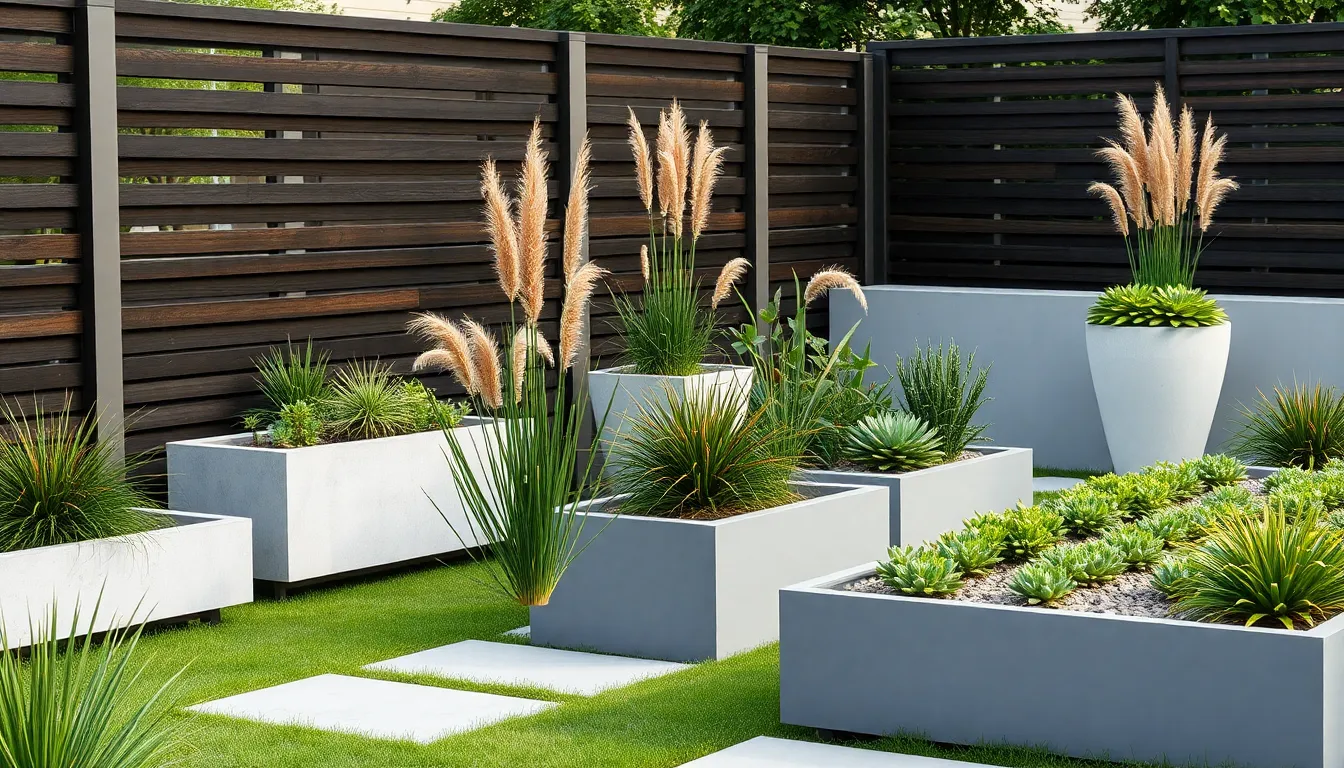
Contemporary fence gardens combine clean architectural lines with innovative materials to create sophisticated outdoor spaces. We’ll explore how modern design principles can transform your fence into a striking garden feature that complements today’s minimalist lifestyle.
Geometric Planter Arrangements
Geometric planter arrangements bring structure and visual rhythm to contemporary fence gardens through precise, modular designs. Squares, rectangles, and hexagons arranged in repeating patterns create compelling focal points that emphasize order and symmetry along fence lines.
Materials and Construction Options:
| Material | Durability | Style Impact | Maintenance Level |
|---|---|---|---|
| Concrete | High | Bold, industrial | Low |
| Metal | High | Sleek, modern | Medium |
| Wood | Medium | Warm, natural | High |
Concrete planters deliver bold geometric impact while requiring minimal upkeep throughout seasons. Metal containers offer sleek profiles that complement horizontal fence panels and contemporary architecture. Wood planters provide warmth and natural texture that softens the stark lines of modern designs.
Plant Selection for Geometric Displays:
- Ornamental grasses like fountain grass and feather reed grass
- Low shrubs such as boxwood and dwarf barberry
- Seasonal flowers including marigolds and petunias for color rotation
Modular arrangements allow for easy reconfiguration as plants grow or seasonal needs change. Spacing planters at regular intervals creates visual continuity that guides the eye along fence lines while maintaining the clean aesthetic of contemporary gardens.
Minimalist Succulent Displays
Minimalist succulent displays embody the essence of contemporary gardening with their low maintenance requirements and architectural plant forms. These installations work particularly well in urban settings where space constraints demand efficient use of vertical surfaces.
Installation Methods:
- Shallow linear planters mounted horizontally along fence panels
- Vertical mounting systems for wall-mounted displays
- Geometric clusters arranged in neat rows or patterns
Succulents planted in linear arrangements create horizontal emphasis that complements modern fence designs. Vertical installations maximize growing space while adding textural interest without overwhelming the minimalist aesthetic. Geometric clustering reinforces the orderly appearance that defines contemporary garden spaces.
Recommended Succulent Varieties:
- Echeveria for rosette formations and color variety
- Sedum for ground cover and trailing effects
- Haworthia for architectural structure and unique patterns
Maintenance involves minimal watering and occasional repositioning to accommodate growth patterns. These displays thrive in various lighting conditions and adapt well to seasonal temperature changes typical in fence garden environments.
Industrial Metal Garden Features
Industrial metal features bring durability and contemporary sophistication to fence garden designs through rust resistant materials and clean geometric forms. These elements serve both functional and aesthetic purposes while requiring minimal maintenance over time.
Core Metal Components:
| Feature Type | Primary Function | Design Impact |
|---|---|---|
| Steel planters | Plant containment | Bold, structural |
| Galvanized troughs | Water drainage | Industrial, utilitarian |
| Metal screens | Privacy, support | Decorative, functional |
Rust resistant steel planters provide long lasting containers that develop attractive patina over time. Galvanized troughs offer excellent drainage answers while maintaining the industrial aesthetic that defines contemporary gardens. Powder coated metal screens serve dual purposes as privacy barriers and support structures for climbing plants.
Enhanced Features:
- Metal trellises supporting climbing vines like clematis and honeysuckle
- Mesh panels creating vertical growing surfaces for lightweight plants
- Integrated lighting systems highlighting metal textures after dark
- Water feature integration adding movement and sound elements
Climbing plant support systems maintain clean lines while accommodating natural growth patterns. Integrated lighting transforms metal features into evening focal points that extend garden enjoyment beyond daylight hours. Water features incorporated into metal structures create sophisticated focal points that enhance the modern appeal of industrial garden designs.
These metal installations complement minimalist landscaping and pair exceptionally well with horizontal fence panels and contemporary home architecture.
Budget-Friendly Fence Garden Solutions
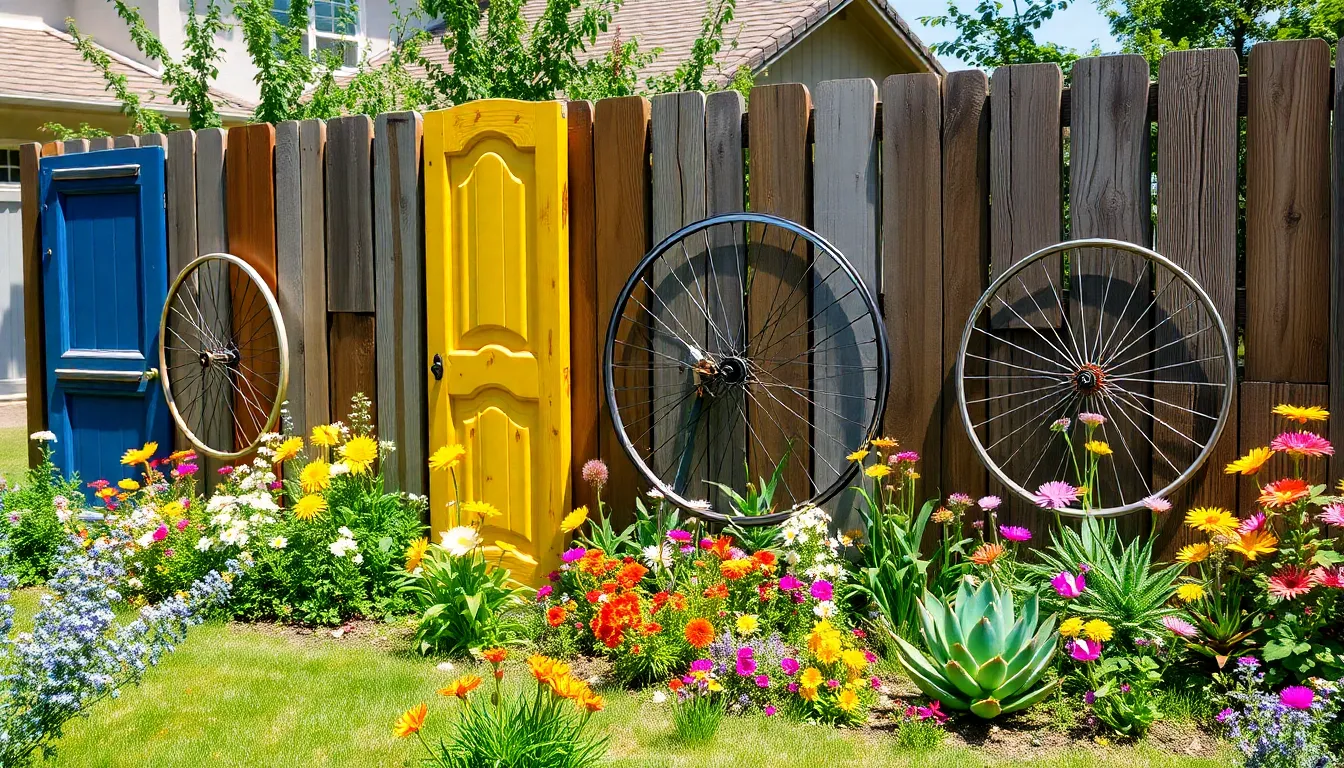
Creating stunning fence gardens doesn’t require expensive materials or professional installation. We’ll explore cost-effective approaches that transform ordinary fences into productive growing spaces using readily available resources.
Recycled Material Projects
Reclaimed doors become stunning fence panels that add character to any garden space. We can transform vintage doors into unique vertical gardens by adding planter boxes or mounting hooks for hanging containers, creating conversation pieces that cost significantly less than new fencing materials.
Old skis and bicycles offer unexpected opportunities for creative fence designs. Mounting vintage skis vertically creates rustic fence sections, while repurposing bicycle wheels as decorative elements adds whimsical charm to garden boundaries.
Ironing boards provide surprisingly effective fence sections when positioned upright between posts. These quirky additions create perfect supports for lightweight planters and offer built-in shelving for small potted plants.
Wooden pallets deliver exceptional value as fence garden foundations, costing as little as $10-15 each when purchased from hardware stores. We can easily convert these versatile structures into vertical planters by adding industry fabric backing and filling the slats with potting soil.
Seed Starting Systems
Mini greenhouses using glass containers or clear plastic bottles create perfect environments for starting seeds at minimal cost. We position these makeshift greenhouses along fence bases where they receive optimal morning sunlight while staying protected from harsh afternoon heat.
Seed trays with built-in covers allow us to start dozens of plants indoors before transferring them to fence garden installations. These systems typically cost $15-25 and can be reused for multiple growing seasons, making them incredibly cost effective for establishing fence gardens.
Cold frames constructed against fence surfaces extend growing seasons by 4-6 weeks in most climates. We build these using old windows or clear plastic sheeting, creating protected spaces where seedlings can develop before transplanting to permanent fence garden locations.
Low-Maintenance Plant Choices
Succulents require watering only once every 7-10 days during growing season, making them ideal for busy gardeners or water conscious landscapes. We recommend varieties like hens and chicks, jade plants, and echeveria that thrive in fence mounted containers with minimal care.
Wildflowers including black eyed Susan, purple coneflower, and blanket flower establish easily and return year after year with virtually no maintenance. These hardy perennials adapt to various soil conditions and provide continuous blooms throughout the growing season.
Native plants exact to our local regions require 50% less water than non-native species once established. We choose plants like native grasses, regional wildflowers, and indigenous shrubs that naturally resist local pests and diseases while supporting beneficial insects and birds.
Seasonal Fence Garden Ideas Throughout the Year
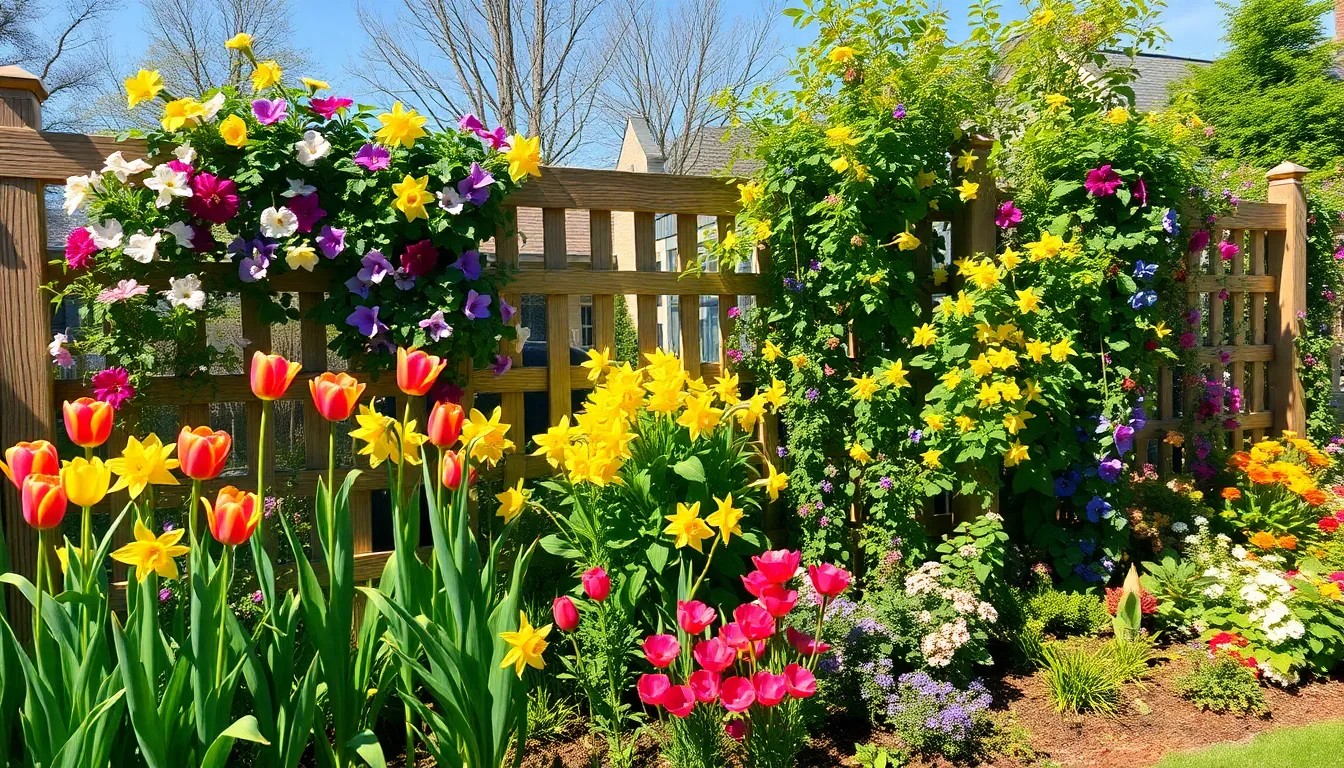
We can create stunning fence gardens that evolve with each season, ensuring year-round beauty and interest. Strategic planning allows us to maintain vibrant displays from spring’s first blooms through winter’s structural elements.
Spring Bulb Displays
Plant tulips, daffodils, and hyacinths along fence lines during fall for spectacular spring color shows. We recommend spacing bulbs 4-6 inches apart to create dense, impactful displays that emerge as temperatures warm. Azaleas and hydrangeas planted near fence bases provide colorful backdrops that complement early bulb blooms.
Layer different bulb varieties for extended flowering periods throughout spring months. Early bloomers like crocuses appear first, followed by daffodils in mid-spring, then tulips for late spring color. We suggest planting bulbs at varying depths according to package instructions to ensure proper growth and blooming sequences.
Create naturalized bulb clusters that return year after year with minimal maintenance. Species tulips and smaller daffodil varieties multiply naturally, forming larger colonies over time. We find these permanent plantings offer excellent value and increasing beauty as they mature.
Summer Annual Arrangements
Transform fences into living trellises using climbing plants like clematis, roses, and morning glories. We recommend installing sturdy support systems before planting to accommodate mature plant weights and wind resistance. These vertical gardens create depth and dramatic height while maximizing growing space.
Fill fence borders with vibrant annuals including sunflowers, zinnias, and marigolds for continuous summer color. We plant these varieties in succession every 2-3 weeks to ensure constant blooms throughout the growing season. Sunflowers positioned against fences create impressive height while requiring minimal ground space.
Incorporate annual vines that climb fence structures for fast-growing privacy screens. Morning glories and moonflowers provide quick coverage while producing abundant flowers. We recommend starting these from seed directly sown at fence bases for best establishment and growth rates.
Fall and Winter Interest Plants
Install evergreen shrubs like boxwood and holly along fence lines to maintain structure during dormant seasons. We position these permanent plantings strategically to create year-round backbone elements that support seasonal displays. These shrubs provide texture and form when flowering plants retreat.
Add winter-blooming plants such as camellias and winter aconite for unexpected seasonal color. We select varieties that thrive in our exact climate zones to ensure reliable winter performance. These specialized plants offer unique beauty when most gardens appear dormant.
Incorporate structural elements including obelisks and arches to provide architectural interest through colder months. We install these features during fall to support climbing plants while creating visual focal points. Decorative elements maintain garden appeal even when plants lose their leaves or go dormant.
Create raised beds along fence lines to support diverse plant communities and improve drainage. We build these elevated growing areas to accommodate both seasonal displays and permanent plantings. Raised beds offer better soil control and make plant maintenance more accessible throughout the year.
Privacy Fence Garden Ideas for Outdoor Living

Creating private outdoor sanctuaries becomes effortless when we combine strategic plant selections with thoughtful design elements. These fence garden approaches transform ordinary boundaries into functional living spaces that offer both seclusion and beauty.
Dense Screening Plants
Dense screening plants along fence lines create natural barriers that enhance privacy while reducing unwanted noise from neighboring properties. Evergreen trees and shrubs work exceptionally well for year-round privacy, maintaining their foliage through all seasons. Arborvitae, holly, and boxwood hedges form thick walls of greenery that block sight lines effectively.
Deciduous screening options provide excellent privacy during warmer months when we spend more time outdoors. Fast-growing bamboo creates instant screening, though we recommend clumping varieties to prevent spreading. Native shrubs like ninebark or serviceberry offer seasonal interest while supporting local wildlife.
Strategic placement maximizes screening effectiveness by filling gaps between existing fence posts. We can layer different plant heights to create a more natural appearance that blocks views from multiple angles. Maintenance remains minimal once these screening plants establish their root systems.
Multi-Level Garden Borders
Multi-level garden borders with taller plants positioned in the back and shorter specimens in front create layered looks that add remarkable depth to fence gardens. This tiered approach maximizes vertical space while ensuring each plant receives adequate sunlight. Background plantings might include ornamental grasses or small flowering trees.
Middle tier selections work perfectly for seasonal color and texture variation. Perennial flowers, medium-height shrubs, and decorative grasses fill this crucial space between tall screens and ground-level plantings. We recommend choosing plants with different bloom times to extend visual interest throughout growing seasons.
Ground level plantings complete the layered design with low-growing perennials, bulbs, and spreading groundcovers. These foundation plants unite the entire border while suppressing weeds naturally. Careful plant spacing prevents overcrowding as specimens mature and reach their full size potential.
Integrated Seating Areas
Integrated seating areas within fence garden designs invite relaxation and create opportunities to enjoy our outdoor spaces more fully. Placing benches near lush plantings establishes intimate garden rooms where we can appreciate our landscaping efforts up close. Natural stone or wooden benches complement organic garden settings beautifully.
Pergolas positioned along fence lines provide overhead structure while supporting climbing plants that enhance privacy. These architectural elements create defined outdoor rooms that feel separate from surrounding spaces. We can add comfortable outdoor furniture to transform these areas into true outdoor living rooms.
Simple seating answers like built-in planters with wide caps offer dual functionality as both growing space and casual seating. Garden stools and weatherproof cushions make these areas more comfortable for extended outdoor enjoyment. Strategic lighting extends the usability of these spaces into evening hours.
Conclusion
We’ve shown you countless ways to transform your fence from a simple boundary into a thriving garden masterpiece. Whether you’re working with a tight budget or have room to splurge these ideas prove that any fence can become a beautiful living feature.
Your fence garden journey doesn’t have to start big. Pick one project that excites you most and begin there. You’ll be amazed at how quickly your outdoor space transforms into something truly special.
The best part? These gardens keep giving back season after season. You’ll enjoy fresh herbs privacy beautiful blooms and the satisfaction of creating something uniquely yours. Your fence will never look ordinary again.
Frequently Asked Questions
What are fence gardens and how do they work?
Fence gardens transform ordinary fences into vertical growing spaces using planters, trellises, and climbing plants. They maximize limited space by utilizing vertical surfaces for growing flowers, herbs, vegetables, and vines. These gardens enhance curb appeal while providing privacy screens and productive growing areas without requiring major construction or high costs.
What are the best plants for fence gardens?
The best fence garden plants include climbing roses, clematis, morning glory vines, pole beans, cucumbers, herbs like basil and thyme, succulents, and evergreen shrubs. Choose plants based on your fence’s sun exposure, climate zone, and desired function—whether for privacy, food production, or decorative appeal.
How much does it cost to create a fence garden?
Fence gardens can be created on any budget. DIY projects using recycled materials like pallets, mason jars, and repurposed containers cost under $50. Mid-range projects with new planters and quality plants range from $100-300. Professional installations or extensive living walls may cost $500-2000 depending on size and complexity.
What tools and materials do I need for DIY fence gardening?
Basic fence gardening requires a drill, screws, brackets, planters or containers, potting soil, and plants. Specific projects may need pallets, mason jars, hanging hardware, or trellis materials. Most supplies are available at hardware stores and garden centers, with many materials being repurposable household items.
How do I maintain a fence garden throughout the seasons?
Maintain fence gardens by watering regularly (check containers more frequently as they dry faster), fertilizing monthly during growing season, pruning climbing plants, and replacing seasonal annuals. In winter, protect containers from freezing, add evergreen elements for structure, and plan spring plantings. Choose low-maintenance plants to reduce upkeep.
Can fence gardens provide privacy and attract wildlife?
Yes, fence gardens excel at both privacy and wildlife attraction. Dense climbing plants, evergreen shrubs, and layered plantings create natural privacy screens. Flowering plants attract pollinators, berry bushes feed birds, and diverse plantings support beneficial insects. This creates a thriving ecosystem while maintaining your outdoor privacy.
What are the best fence garden ideas for small spaces?
Small space fence gardens benefit from vertical solutions like hanging basket systems, pocket planters, living wall modules, and tiered arrangements. Use compact plants like herbs, succulents, and trailing varieties. Mason jar herb gardens, pallet planters, and modular systems maximize growing space without overwhelming limited areas.
How do I choose between flowering and edible fence gardens?
Consider your priorities: flowering gardens provide beauty, fragrance, and wildlife habitat, while edible gardens offer fresh produce and herbs. You can combine both approaches—use climbing vegetables like beans for structure, add herb walls for cooking, and include flowering plants for pollinators and visual appeal.

